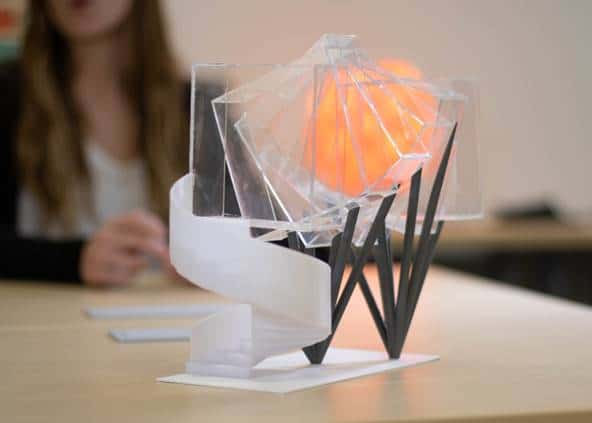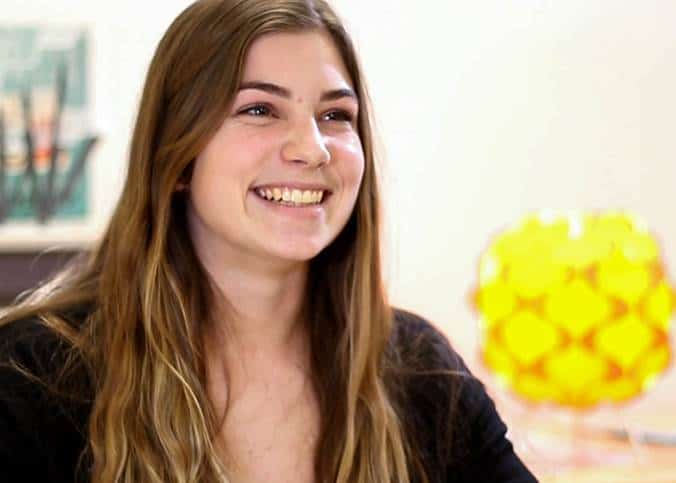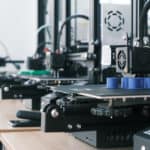📍 Algonquin College DARE Dictrict MakerSpace, Ottawa, Ontario
Course Assignment: Design and build a model of a kiosk destined to operate in the ByWard Market, Ottawa’s shopping, dining and arts hub.
Process: With the guidance of a technician, students fabricate models in their school’s maker environment using computer-aided drafting software, a 3D printer and a laser cutter.
Result: An acrylic model of a mini-library and cozy reading space—and student’s ideas and creativity brought to life through a hands-on DIY project.
“It was neat, because I’d never done anything like that before—it made me feel smart to pull off something like that,” says Sophie Lecours, a third-year student in the Architectural Technology diploma program at Algonquin College who completed the assignment for a first-year visual communication course. “I remember sitting in front of the 3D printer as it was working and thinking, this is so cool.”

A 3D printed stand, with a person off in the background. 
The MakerSpace at the college’s Ottawa campus is a place where students, faculty members, researchers and the community at large can explore, tinker and invent. Through innovation, creativity and collaboration, makers engage in activities that build and reinforce competencies in science, technology, math and engineering.
The showstoppers in this 90 square-metre workshop are its diverse range of entry-level maker tools and technologies: not only those Lecours used, but also virtual reality headsets, a vinyl cutter, Lego Mindstorms (programmable robots), kits for building electronic circuits, and software for 3D design, building websites and apps, and developing animated films, among other options. But equally vital are the two skilled technicians who help users conceptualize and craft their creations.
“Exploring new ideas and learning new skills is how innovation happens,” says Matthew Jerabek, Associate Manager of Marketing and Communications for Algonquin College’s Office of Applied Research, Innovation & Entrepreneurship. “People get excited about what they can achieve—that is where the magic happens.”
That magic has manifested itself in many projects produced by students from a variety of academic disciplines, including graphic design, information technology, media arts and civil engineering technology. One such project involved a group of students conducting pioneering research into polylactic acid, a biodegradable, corn-based plastic. Others have been more playful—3D-printed objects such as a robot pencil holder named Pangolin and an elaborate mask from the movie Black Panther.
To date, much of this creative work has evolved as users in the space share ideas, techniques, challenges and solutions—what Jerabek terms “creative collisions.” During the COVID-19 pandemic, safety measures prevent in-person access to the space, but the technicians provide design and production support through remote, virtual consultations. The team is also continuing to offer workshops—all online—on topics such as 3D design basics, the electronic prototyping platform Arduino, and Twitch, a live-streaming video service for gamers.
Algonquin launched its MakerSpace in 2018 as one element of its DARE (Discover, Applied Research and Entrepreneurship) District, a high-tech, multidisciplinary learning and innovation hub. Two years in the making, at a cost of almost $45 million, half of which came from the federal and provincial governments, the three-floor facility features a Multimedia Production Facility, an Energy Research Lab, a Data Analytics Centre and a Digital Literacy Lab.
The driving idea behind the MakerSpace—that making something with one’s own hands fosters creativity, critical thinking and collaboration—is one that has been reshaping how schools deliver technical education over the last decade. Developments such as widely accessible internet, inexpensive digital tools and society’s increased prioritization of STEM skills have propelled the rise of makerspaces in K-12 and post-secondary institutions. Also known as hackerspaces and FabLabs (“fab” standing for “fabrication”), makerspaces embrace a constructivist pedagogy, in which teachers engage students in experiential building projects ranging from the simple—for example, elementary students making a whack-a-mole game using cardboard, scissors and tape—to the sophisticated—such as using 3D printing technology to create prosthetic limbs.
Like many other school-based maker facilities, Algonquin’s is open to local businesses and other organizations. In May, amid concerns about shortages of personal protective equipment during the first wave of the pandemic, it participated in a community drive to produce face shields that involved the Children’s Hospital of Eastern Ontario, University of Ottawa medical students, the grassroots health-care movement Hacking Health Ottawa, and the Thistledown Foundation, a private charity that focuses on tech solutions for decarbonization but pivoted to COVID support efforts when the global pandemic hit.
And then there is 14-year-old Aaryan Harshith, who recently made good use of the MakerSpace to realize a medical innovation: an AI-powered, non-invasive device that uses light waves to identify cancer cells. Over three months, the technicians at the MakerSpace helped Harshith design and develop a prototype, assisting with building electric circuits, 3D printing and solving technical issues. The resulting hand-held probe allows surgeons to determine whether cells are cancerous or healthy in real time so they can operate more effectively.
“If you want to invent something, there are a lot of barriers to entry. With its equipment and expertise, the MakerSpace removes a lot of those barriers,” says Harshith, who is now working to bring his medical device to market. “Without that space, this would still be a theoretical rather than a real-life project, so it made a huge difference.”
